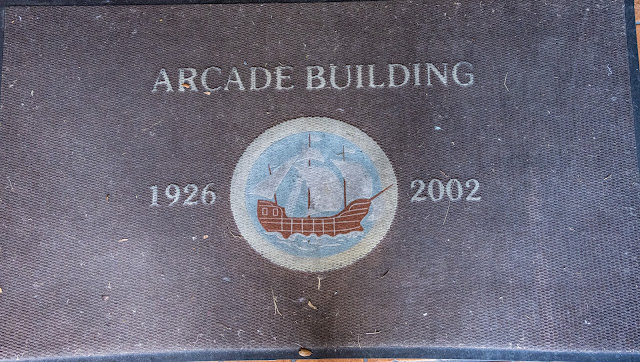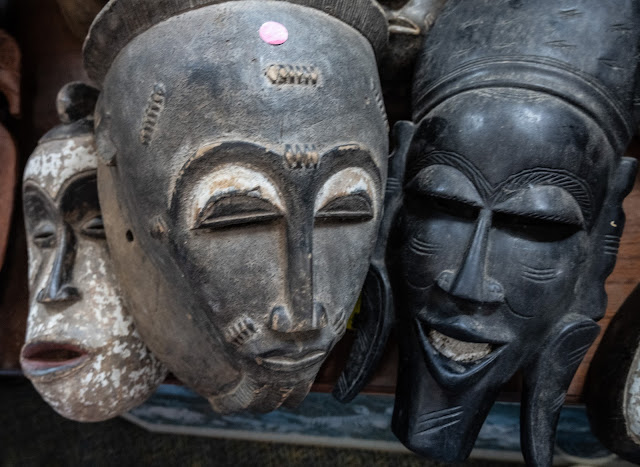The arcade building was an early mall type shopping center built during the Florida Land Boom era.
Built in a Spanish Colonial Revival style in 1926, it was the largest commercial building in Fort Pierce. In the 1950's the building caught on fire, but it survived.
Later on the building was used for retail and office space until the 1980s when another fire damaged a third of the structure causing the building to be shut down.
On October 12, 2001, the structure was listed on the U.S. National Register of Historic Places.
The facade and the interior were restored in 2002. Its restoration was a major priority in the city's redevelopment.
Eye-catching murals envelope the outside of the building (on the north & west) and create a sense of nostalgia for many. These murals depict the heyday of the Arcade Building – Canaday’s Drugs, Ranchland Clothing Store, the military presence in Fort Pierce and much more.

Stepping inside the building one notices a tastefully decorated hallway with wonderful retail space on the first floor, and nice office space on the second floor.
He saw my camera and smiled 😉
On a couple of walls there are beautifully painted murals.
Each of the murals telling a story related to Fort Pierce.

- PP Cobb General Store sold
“Everything to Eat, Wear and Use.”
- Gold coin salvage from the Spanish Treasure Fleet.
As early as 1565, Spanish sailors were searching the Indian River Lagoon
for shipwrecked countrymen.
- Louise Jones Gopher was the first
Seminole girl to graduate from Indian River Community College.
- A 1940’s poster for the War Production Co-cordinating
Committee.
- The Betty Weens Freighter was the first large
vessel to sail through the new Fort Pierce Inlet constructed in 1921. The
“natural” inlet was located to the North of this site.
- A Dance Studio taught the latest steps on the
second floor of the Arcade Building.
- Brahma Cattle were one of the first breeds
imported to improve local stock for the growing cattle industry.
- In 1925 Old City Hall was built on Avenue A,
one year before the Arcade Building opened.
- Rumor has it that local resident Bill Anderson
was a member of the Jesse James Gang.
- This Ais (Ays) Indian Shell Mound on South
Indian River Drive dates back almost 2,000 years ago.
- Bee-keepers produced delicately flavored
Orange Blossom honey.
- The St. Augustine Paddle Steamer, called a
stern-wheeler, carried passengers, supplies and news from the north.
- Vast schools of fish provided sport and food
for the settlers.
- Hogg’s Trading Post was a fish cannery
in 1880. This area of Fort Pierce, south of Moore’s Creek, was called “Can
Town.”
- Senator Dan McCarty on an official visit
to Fort Pierce. He went on the be the first and only Florida Governor to
come from Fort Pierce.
- Citrus became a major industry and
established the area’s reputation as the biggest grapefruit producer in
the world.
- Seminole Indians traveled the
waterways in boats carved from hollowed-out trees.
- Replica of the original ship medallions
decorating the Arcade Building.
- Beachcombing was always popular on the
Treasure Coast.
- Local attorney, Florida Supreme Court Judge and
cattleman, Judge Alto Adams, Sr. developed the Adams Ranch
located west of town.
- The old St. Lucie County Courthouse. In 1901,
Fort Pierce was a thriving business center with shipping and railroad
depots.
- Famed artist, A.E. “Beanie” Backus held annual
Halloween parties that were always inter-generational and inter-racial.
- Delivering pineapples and bananas.
Before the big freeze in 1894/1895, pineapple fields stretched along the
Indian River from Stuart to Vero Beach.
- The first Navy Frog Men in the United States
were taught at the Amphibious Training Base during World War II.
- Peacocks still roam Orange Avenue, displaying exotic plumage.
- The Arcade Building in
1948 – view from US HWY 1 (then 4th Street) looking north. Originally
built in 1926, the historic restoration took 3 years of research,
dedication and hard work.
- Fort Pierce was named after Lieutenant
Colonel Benjamin Kendrick Pierce in 1838. His brother, Franklin
Pierce, became the 14th President of the United States.
- Drying cotton nets at the Sample
Family Fish House. Commercial fishing provided many jobs for local
residents.
- Celebrating 4th of July at the bandstand
across from the PP Cobb General Store on Indian River Drive.
- Four of the characters in this
mural were sketched from Norman Rockwell’s inspired illustrations
of American Life.
- Fort Pierce Band played stirring music at local events.
- Moore’s Creek Bridge, a favorite fishing hole, had a two-plank sidewalk
leading to Avenue A.
- Author and Playwright Zora
Neale Hurston, traveled the south collecting colorful African-American
folklore. Her house in Fort Pierce is listed on the National Register of
Historic Places.
- Saturday matinees at the Sunrise
Theatre, built in 1923, was restored and opened again in 2006.
- A 1908 family portrait with one
of the first automobiles in Fort Pierce.
- Steam Trains arrived in Fort Pierce after the tracks had been
extended south in 1894.
- In 1908, Fort Pierce School,
North 2nd Street, had just 253 students.
- Elephants parade Orange Avenue
when the Barnum Bailey Circus came to town in 1959 and set up the
big top at St. Anastasia School.
- “Gandy Dancers” (a slang term used for early railroad workers) used
hand-pumped carts to reach railroad sections in need of repair.
- Dr. Platts and family, the first doctor, also established the first drug
store at eh southeast corner of Avenue A.
- Goods were delivered to early
settlers in horse-drawn wagons.
And of course that is not all one finds in this beautiful building. A short walk down the hallway and you are in "Africa".
Like everything else in this building, there is a story behind this African art store.
Sixty-three year-old Ndiaga Niang opened his African Art, Antiques and Gifts shop more than three years ago. The chock-full store offers everything from home decor to clothes, jewelry and accessories to incense, shea butter and black soap — all imported from artists across Africa. There are African drums, baskets, textiles as well as drinkware.
Niang immigrated from Senegal and began life in the U.S. as a dishwasher in a New York restaurant, over 30 years ago. On his days off from the restaurant, Niang began selling T-shirts as a side business. During that time, someone asked if he had any African art to sell. That led to him trying to find some, setting him down the path of becoming an art dealer.
Niang opened art stores in Indiana and Kentucky, and made trips to Florida to sell his wares at festivals.
Eventually that led to him relocating to Florida and choosing Fort Pierce because of its proximity to Interstate 95 and Florida's Turnpike.
A bonus was the city's efforts to revitalize the Orange Avenue corridor, called the Peacock Arts District.
Stepping outside the Arcade Building and Niang's shop one finds oneself in the Peacock Art District or PAD for short.
This part of town was a bustling commercial corridor until the 1970s. Woolworth's, Grant's Furniture store, a pharmacy and a host of other businesses made this a popular retail corridor. But like every town around the country the streets became full of shuttered buildings.
Arts districts typically boast live-and-work studios, restaurants and specialty stores. They attract people of all ages and backgrounds.They help bring life and vitality back to neglected commercial and industrial parts of cities.
The City of Fort Pierce recognized that something needed to be done to help refresh the area, hence announced a call for submissions for murals.
The city provided a stipends of $1000-$1200 plus reinbursement for materials used to artists who sent in a written proposal. Criterias were set for artist selection and the project was completed by September of 2019.
The number of murals and art work around the area is much higher than the two photos I was able to capture.These are just a sampling of what was created.
Of course as you notice the above mural is that of a peacock.
I am sure you are wondering why call an art district peacock?
Why have murals of peacocks?
🤔🤔🤔🤔🤔🤔🤔
While driving around the block I noticed a couple of yellow signs stating:
"Peacock Crossing"
As my husband and I were discussing the oddity of these signs in the middle of the town...I spotted a peacock.
Of course I had to get out of the car and chase the peacock in hopes that maybe he would open up his beautiful tail and I could go "click".
Needless to say that never happened but it did lead me to search for an answer to the above questions/wonderings.
Eventually, it landed me here......
As Paul Harvey would say: "And now, the rest of the story."































































0 comments:
Post a Comment